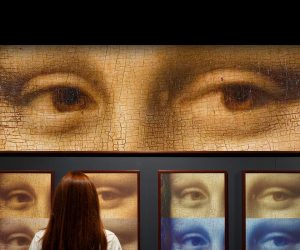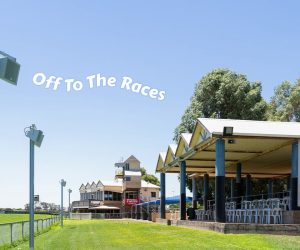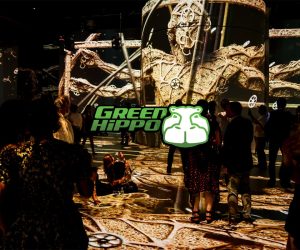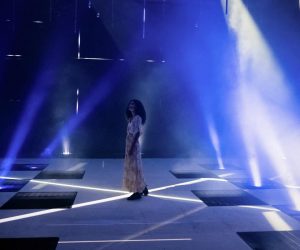
The da Vinci Mode
Haughty auteur, Peter Greenaway, presents a very different take on ‘Leonardo’s Last Supper’.
Text:/ Jason Buchanan
Images:/ Courtesy Melbourne International Arts Festival
One of the Melbourne International Arts Festival’s main drawcards this year was the Peter Greenaway work, ‘Leonardo’s Last Supper’, held at the North Melbourne Town Hall. First shown in Milan in 2008 as part of the I Saloni Fair, Leonardo’s Last Supper is a multimedia production created by visionary film maker and artist, Peter Greenaway, and makes extensive use of multiple projected images layered over a full-size fully-detailed replica of the original da Vinci painting. The production incorporates multi-channel audio, synchronised programmed lighting and a set with fully rendered walls, windows and doorways. Greenaway emphasises the elements of the original masterpiece and brings the layers and forms forward by use of intricate and detailed animation and projection, fusing traditional art with modern multimedia.
The painting and the room almost literally come to life with animations highlighting such elements as the outlines of the human forms and the sunlight streaming through the windows to produce realistic shadows on the figures. The projections identify the human figures in the piece, both as groups and individuals, creating moods, isolating characters, and both reinforcing the colours and textures of the original work, and at times creating new and vastly differing hues and tones.
Accompanying the painting is a huge table placed in the middle of the room. On it are simple white objects that replicate the items seen on the table in da Vinci’s painting. Throughout the show the lighting highlights areas of the table and particular items of cutlery and crockery corresponding to similar areas highlighted by projections onto the painting. The room is filled with visual movement from the lighting and projection and auditory movement created by the multi-channel audio installation.
TABLE TABLEAU
AV spoke with the Project Manager, Matteo Massocco, to discover what was involved in bringing such a project to Australia, and how this production differed from its Milan debut.
“This is the first time the production has toured outside of Italy where it premiered in 2008. There was a larger setup there, because the space was bigger than what it is here. For the Milan show, which ran for six months, we set up a total of nine video projectors, with nine channels of vision playback using a Dataton Watchout system. Then we also had the opportunity to do one night where we projected onto the original painting, which was a lot simpler, because you are not allowed to bring almost anything inside the room for conservation reasons. That one-off show was done with eight projectors with UV filters on them, dimmed down because you can only direct a certain limited level light onto the painting. Now we have come here to Australia as part of the Melbourne Festival, and this particular installation is based on five projectors, one on the main painting clone itself (a Christie Roadster S+16K – 16000 lumen, three-chip DLP), two on the back wall and one on either side of the painting for the side walls (all Christie HD10K-M – 10000 lumen, three-chip DLP). This setup is controlled by five channels of Watchout.”

I DON’T KNOW ART, BUT…
The cloned painting is the focal point of the work and is the basis for the projection content. The clone was constructed by Factum Arte, a London/Portugal-based company which specialises in recreations of large artworks. The original Last Supper painting was photographed in sections at very high resolution then recreated right down to the texture of the surface and the exact matching of the tones of paint in the original. Matteo explains the recreation process:
“Factum Arte has copied a number of works, but it is not a simple process. It is based on an aluminium frame covered with plaster and the plaster is sculptured in a way to copy the original texture of painting. It is then printed and fixed onto single panels. These have to be stitched together and retouched. This then becomes four big panels that can be transported and we can set them in place in the venue on scaffolding. Once you have them perfectly set in position and level, all the seams need to be filled and retouched. Touching up the edges by the restoration team takes about five days, and involves filling all the seams with a special material. Once this is dry they have to hand match the exact colours to complete the image.”
STARS ALIGN
During the 20-minute performance, the importance of precise alignment of the projection and lighting systems becomes clear. Matteo explains:
“In Milan, it was very difficult. Being the first time, we spent a very long time standing in front of the painting and making adjustments. But here it wasn’t as long, as the painting is the same: same dimensions and characteristics. A lot of the work had already been done, so we just had to match it and warp it correctly.
“To explain further – the projected image on the main painting was created using the 3D digital compositing tool Eyeon Fusion, and has been pre-rendered in 3D because we have to exactly match the painting. You have masks in various places, but then you have to move every single pixel on a grid to warp it, and when you find the right warp, you then have to render it all with this warping. Any later editing was done using Final Cut Pro and all the images on the main painting have been done using this process. We decided to use Watchout for the projection, because it makes our life easier, not just for playback, but it also helps a lot for the tweaking of the image and was easier to take care of the masking processes on the clone painting.”
“”
this installation is based on five projectors, one on the main painting … two on the back wall and one on either side of the painting for the side walls




Greenaway uses projection to analyse and annotate the content of da Vinci’s painting., playing with the light sources, pointing out the compositional devices and tricks, and even restoring the part of the painting that was lost when a new door was cut in the wall of the monastery.
THE PROJECT
Peter Greenaway Leonardo’s Last Supper is a project by Change Performing Arts and Superintendency for Architectural and Natural Heritage of Milan in collaboration with Municipality of Milan/Culture Council commisioned by Cosmit Milan on the occasion os Salone Internazionale del Mobile 2008 under the patronage of Federlegno-Arredo.
A Vision by: Peter Greenaway
Visual Design: Reinier van Brummelen
Music: Marco Robino
Performed by: Architorti
Sound Editing: Stefan Scarani
High Definition Photography: HAL9000
Digital Characters Sculptor: Rod Seffen
Compositing: Neda Gueorguieva
Facsimile/Clone Production: Factum Arte
Production Director: Franco Gabualdi
Technical Director: Amerigo Varesi
Light Design: Marcello Lumaca
SUPPORTING CAST
Although the painting is the focus for the performance, it is supported by other images panning across the surface of the painting from the side panels of the set and images projected on the entire rear wall; a process that Matteo explains:
“The side panels are more difficult to cover because you are projecting from the front onto a three dimensional surface. so with Fusion you can set up a virtual camera where the projector will be mounted and this is used to create a render of the surface characteristics you’re projecting onto. The virtual camera is used to create an image of the actual surface to allow the projected image to be mapped exactly onto the 3D model.
“The main issue of the whole work is we are overlaying the projections on the clone painting, not obscuring it with projected images. What you are seeing is a blend, so matching tones and lines may be very subtle, or may be very sharp… matching and melding within the original.”
Other production elements play important supporting roles in Greenaway’s work, as Matteo explains:
“The lighting works in strongly with the vision. When the focus is on Christ and the centre of the table on the painting, the same happens on the table in the room with the lighting. This also happens when the blood appears on the table on the painting. When the blood droplets run down, the physical table turns red. The lighting is very reactive to what is happening with the projection on the painting. In regards to the design, we focused more on sharp edges from above the table, so essentially the lighting design was really done in response to the set.”
CHANNELLING DA VINCI
The audio was being run from a Fostex hard disk recorder, which was the coordinating hub for the show, feeding timecode to both the Watchout system and the lighting console. The audio component itself was spread across six channels, each feeding an independent speaker. Matteo again:
“Essentially the audio for the six speakers is simply to create a little depth. There are two central channels for the narrative voice, while the front and the back channels are instrumental parts only. All tracks were recorded on standard stereo originally, and this was then moved to six channels. It really is only a subtle difference with high-end and low-end between front and back.”
IN A NEW LIGHT
Peter Greenway has built a reputation for combining his twin obsessions of the visual arts and film-making to produce unusual, confronting and exciting films that break out of their frames in unexpected ways. His work/production/performance/exhibition of Leonardo’s Last Supper is an impressive example of how the visual arts can combine with the arts and technologies of AV to engage audiences and encourage them to look at old and often overlooked art forms in an entirely new light.
LOCAL PRODUCTION & CONSTRUCTION
VIDEO INSTALLATION
Haycom Staging: Graeme Trott, Wayne Nietz
WATCHOUT PLAYBACK SYSTEM
Digital Sets: Mel Padgett
AUDIO
Optical Audio: Jason Read, Jason Buchanan
LIGHTING
Active Lighting: Kevin Robotham
MIAA: Aaron Hock
SET
Onset Design: Osman Saathoff
RIGGING
Element Rigging: Rob Irwin
















RESPONSES